Ecuador is one of the few countries in Latin America with a wide range of local manufacturers, when in other countries there has been a progressive disappearance of bus manufacturers, leaving only the most recognized or those that have been able to innovate to withstand the arrival of the foreign builders.
Although there is an important preference for local manufacturers, regardless of whether many of them have been carried away by copying foreign models; Ecuadorian carriers have been increasingly open to proposals from other countries. The buses of Brazilian origin, followed by the Chinese, Peruvian and occasionally from Colombia; they are in their flotillas.
There is also evidence of a change in the mentality of the country’s transporter, which is gradually passing to the rear-engine bus, especially on longer-distance routes. This arrangement of components allows the incorporation of better-performing vehicles that allow a higher load capacity, an increase in the overall length of the vehicle and its wheelbase.

Precisely these characteristics have been used by Ecuadorian transporters, to bet on buses with the largest hold capacity in the market, with the respectable height of 1,600 mm from the floor to the edge of the passenger lounge, which allows offering almost 21 meters cubic of luggage space. With Transportes Esmeraldas, which in September 2021 received its order for 15 buses, the Campione Invictus HD model built by the Brazilian company Comil, located in Erechim.
“It is not very common to see them in Ecuador, but in this time of pandemic, having good warehouse capacity to transport parcels is an alternative to the drop in the number of passengers, that is why companies are considering them and new units are coming,” explains Ángel. Vinueza, Director of Ecuabus.
The next step has been taken by the Cooperativa San Cristóbal de Tulcán, near the border with Colombia, and Panamericana Internacional in the capital Quito. Both companies, recognized for their long-distance routes in the country and even internationally, have received their orders for the Marcopolo Paradiso 1600LD model, imported to Ecuador by the brand’s representative, Sudacam.

The three companies have opted for the 48-seat configuration, a toilet, half-bed seats with a good level of comfort, and a driver’s bedroom that is located in a lower position. Scania’s participation also stands out, with its high-power K460 platform, with the 12.7-liter engine that is offered throughout South America, but offers more power due to the Euro 3 emission regulations that apply to Ecuador.
To dose that great amount of power, the Opticruise automated 12-speed gearbox is present, while to ensure great ride comfort, the electronically leveling air suspension makes life on board easier. Heavy-duty retarder, ABS and traction control come with safety equipment, which also helps preserve brake material.
Will they become a trend in Ecuador? It cannot be said yet, but new paths have been opened in the matter of passenger transport in the country. “In principle, the novelty was the double-decker buses, but with these high-capacity buses, companies can have an additional line of business and provide facilities to the user because through a transport cooperative it is easier to send packages and merchandise. Companies are taking the issue of parcels very much into account, especially those who can afford to incorporate rear-engine buses into their fleets» Vinueza explains.

At the moment Scania has the leadership in these large buses in 6X2 configuration, gaining more and more market share, capturing this new mentality in transporters that are betting on vehicles with greater driving comfort. This has been motivating other brands, which will not want to lose ground and could surprise themselves in the coming months, with the incorporation of new chassis models for rear-engine buses in Ecuador.

